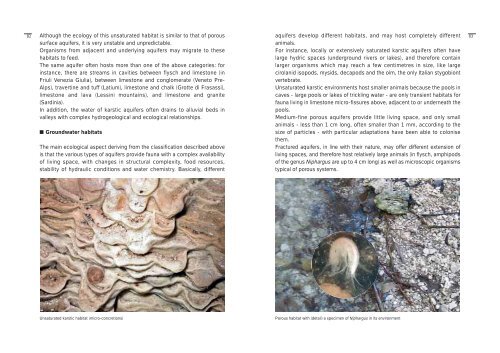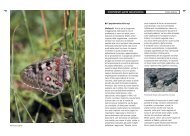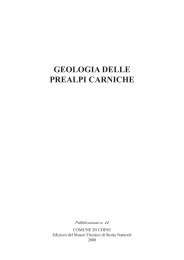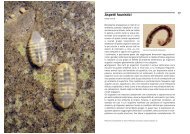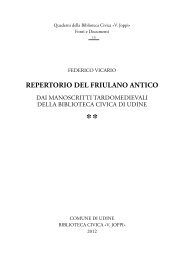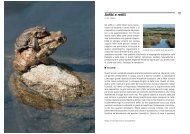Despite its inhospitable appearance and lack of any ... - Udine Cultura
Despite its inhospitable appearance and lack of any ... - Udine Cultura
Despite its inhospitable appearance and lack of any ... - Udine Cultura
Create successful ePaper yourself
Turn your PDF publications into a flip-book with our unique Google optimized e-Paper software.
82<br />
Although the ecology <strong>of</strong> this unsaturated habitat is similar to that <strong>of</strong> porous<br />
surface aquifers, it is very unstable <strong>and</strong> unpredictable.<br />
Organisms from adjacent <strong>and</strong> underlying aquifers may migrate to these<br />
habitats to feed.<br />
The same aquifer <strong>of</strong>ten hosts more than one <strong>of</strong> the above categories: for<br />
instance, there are streams in cavities between flysch <strong>and</strong> limestone (in<br />
Friuli Venezia Giulia), between limestone <strong>and</strong> conglomerate (Veneto Pre-<br />
Alps), travertine <strong>and</strong> tuff (Latium), limestone <strong>and</strong> chalk (Grotte di Frasassi),<br />
limestone <strong>and</strong> lava (Lessini mountains), <strong>and</strong> limestone <strong>and</strong> granite<br />
(Sardinia).<br />
In addition, the water <strong>of</strong> karstic aquifers <strong>of</strong>ten drains to alluvial beds in<br />
valleys with complex hydrogeological <strong>and</strong> ecological relationships.<br />
■ Groundwater habitats<br />
The main ecological aspect deriving from the classification described above<br />
is that the various types <strong>of</strong> aquifers provide fauna with a complex availability<br />
<strong>of</strong> living space, with changes in structural complexity, food resources,<br />
stability <strong>of</strong> hydraulic conditions <strong>and</strong> water chemistry. Basically, different<br />
aquifers develop different habitats, <strong>and</strong> may host completely different<br />
animals.<br />
For instance, locally or extensively saturated karstic aquifers <strong>of</strong>ten have<br />
large hydric spaces (underground rivers or lakes), <strong>and</strong> therefore contain<br />
larger organisms which may reach a few centimetres in size, like large<br />
cirolanid isopods, mysids, decapods <strong>and</strong> the olm, the only Italian stygobiont<br />
vertebrate.<br />
Unsaturated karstic environments host smaller animals because the pools in<br />
caves - large pools or lakes <strong>of</strong> trickling water - are only transient habitats for<br />
fauna living in limestone micro-fissures above, adjacent to or underneath the<br />
pools.<br />
Medium-fine porous aquifers provide little living space, <strong>and</strong> only small<br />
animals - less than 1 cm long, <strong>of</strong>ten smaller than 1 mm, according to the<br />
size <strong>of</strong> particles - with particular adaptations have been able to colonise<br />
them.<br />
Fractured aquifers, in line with their nature, may <strong>of</strong>fer different extension <strong>of</strong><br />
living spaces, <strong>and</strong> therefore host relatively large animals (in flysch, amphipods<br />
<strong>of</strong> the genus Niphargus are up to 4 cm long) as well as microscopic organisms<br />
typical <strong>of</strong> porous systems.<br />
Unsaturated karstic habitat (micro-concretions) Porous habitat with (detail) a specimen <strong>of</strong> Niphargus in <strong>its</strong> environment<br />
83


